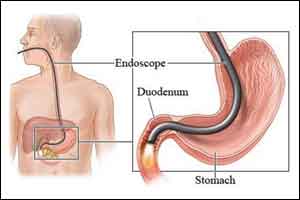- Home
- Editorial
- News
- Practice Guidelines
- Anesthesiology Guidelines
- Cancer Guidelines
- Cardiac Sciences Guidelines
- Critical Care Guidelines
- Dentistry Guidelines
- Dermatology Guidelines
- Diabetes and Endo Guidelines
- Diagnostics Guidelines
- ENT Guidelines
- Featured Practice Guidelines
- Gastroenterology Guidelines
- Geriatrics Guidelines
- Medicine Guidelines
- Nephrology Guidelines
- Neurosciences Guidelines
- Obs and Gynae Guidelines
- Ophthalmology Guidelines
- Orthopaedics Guidelines
- Paediatrics Guidelines
- Psychiatry Guidelines
- Pulmonology Guidelines
- Radiology Guidelines
- Surgery Guidelines
- Urology Guidelines
EUS-Guided Biliary Drainage is safe alternative for benign biliary diseases also

EUS-guided antegrade intervention for benign biliary diseases with surgically altered anatomy SAA appears to be a feasible and safe alternative procedure after balloon enteroscopy-assisted ERCP (BE-ERCP) failure, according to a study published in the journal Gastrointestinal Endoscopy. The findings challenge the reluctance among many endoscopists to perform EUS-guided biliary drainage procedures for indications other than unresectable malignancy.
Although balloon enteroscopy-assisted ERCP (BE-ERCP) is effective and safe for benign biliary diseases in patients with surgically altered anatomy (SAA), BE-ERCP is not always successful. Recently, EUS-guided antegrade intervention (EUS-AI) including a 1-stage or 2-stage procedure has been developed for BE-ERCP failure cases.
Shuntaro Mukai and his associates conducted a study to evaluate the outcome of EUS-AI for benign biliary diseases with SAA.
The researchers performed the percutaneous transhepatic intervention in 11 patients out of 48 patients in whom BE-ERCP failed. Another 37 patients who failed BE-ERCP and underwent EUS-AI for benign biliary diseases with SAA [common bile duct stones (n = 11), intrahepatic bile duct stones (n = 5), anastomotic stricture (n = 21)] from were retrospectively reviewed.
Key study findings:
- EUS-AI for benign biliary diseases with surgically altered anatomy (SAA) appears to be a feasible and safe alternative procedure after BE-ERCP failure.
- The overall technical success of the creation of hepaticoenteric tract by EUS was 91.9% (34/37).
- Moderate adverse events were observed in 8.1% (biliary peritonitis [n=3]).
- One-stage EUS-AI by EUS succeeded in 8 cases (100%) without any adverse events.
- In another 26 cases, 2-stage EUS-AI by ERCP was performed about 1 or 2 months later.
- Endoscopic antegrade therapy under fluoroscopy was successful in 6 cases.
- Per-oral cholangioscopy-assisted antegrade intervention was required in 19 cases (guidewire manipulation across the anastomotic stricture [n=6], cholangioscopy-guided lithotripsy using electrohydraulic lithotripsy [n=13]).
- In 1 case, magnetic compression anastomosis was performed. The final clinical success rate of all EUS-AI was 91.9%.
Read Also: Beware-Endoscopes are a common source of Infection
The researchers concluded that the study provides evidence that EUS-guided bile duct drainage appears to be safe and effective in a novel group of patients.
"The success rate seen here is higher than in virtually all studies of balloon-assisted ERCP (the closest alternative in these patients), and the procedures were much less time-intensive overall. It should be stressed that the EUS-guided biliary drainage procedures performed in this case were done via the antegrade route, which is generally considered more difficult than retrograde approaches, yet the overall success rate was still very high,"write the authors.
For reference log on to https://doi.org/10.1016/j.gie.2018.07.030

Disclaimer: This site is primarily intended for healthcare professionals. Any content/information on this website does not replace the advice of medical and/or health professionals and should not be construed as medical/diagnostic advice/endorsement or prescription. Use of this site is subject to our terms of use, privacy policy, advertisement policy. © 2020 Minerva Medical Treatment Pvt Ltd